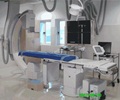According to a study, a new heart-assisting pump does a good job in helping severely ill heart-failure patients survive, and thrive, until they receive a heart transplant.
According to a study, a new heart-assisting pump does a good job in helping severely ill heart-failure patients survive, and thrive, until they receive a heart transplant. The device also helped patients' original hearts regain function and allowed their other organs to heal by restoring blood flow.
The study results are published in the August 30 issue of the New England Journal of Medicine by a team co-led by a University of Michigan Cardiovascular Center surgeon and a Washington Hospital Center cardiologist.The experimental device is called the HeartMate II® left ventricular assist device or LVAD. It is one of four in a new generation of heart-assisting implants that push the blood out of the heart in a continuous flow, rather than a pulsing flow approach used in older devices already on the market.
It is also much smaller than the older devices — about the size of a D-cell battery -— giving it the potential to help more women, teenagers and smaller men with end-stage heart failure whose bodies aren’t big enough for other devices. It’s also quieter and has a smaller tube leading into the implanted device from the controller and battery pack that are worn outside the body.
The study was designed and funded by Thoratec Corporation, which makes the HeartMate II and a larger HeartMate LVAD that is already on the market, but the study’s authors had independent access to the study data to prepare their analysis.
Although the study did not directly compare the HeartMate II device with any other device, the results give further evidence that the new device is more reliable than previous heart-assisting implants. In fact, 68 percent of the 133 patients in the study were still relying on the device after one year while remaining on the heart transplant list. The same clinical trial also includes patients who aren’t eligible to receive a heart transplant, and received the devices as a long-term “destination therapy.”
“As a bridge to transplant, the HeartMate II is showing excellent survival, good recovery potential for the heart, kidneys and liver, and a favorable impact on quality of life,” says Francis Pagani, M.D., Ph.D., co-lead author of the new paper and the director of the U-M Cardiovascular Center’s Center for Circulatory Support. “These results suggest it would be a very good addition to the options that physicians have for treating patients who require ventricular assistance while they wait for a new heart, and that it has the potential to last years rather than months.”
Advertisement
His co-lead author on the paper is Leslie Miller, M.D., a noted cardiologist formerly at the University of Minnesota who is now the director of cardiology programs at Washington Hospital Center.
Advertisement
The new study included 133 patients, and assessed the device’s ability to support patients for six months, or until they received a transplant or recovered heart function, whichever came first. The researchers assessed patients’ functional heart status, as measured by their class of heart failure severity and their ability to walk for six minutes, as well as kidney (renal) and liver (hepatic) function, which are usually diminished by the decreased blood flow from a heart failure patient’s heart. The patients’ quality of life was measured using two standard questionnaires that assess everything from patients’ ability enjoy social activities to their physical day-to-day symptoms and mental health.
Three-quarters of the study participants were men, with an average age of 50. Two-thirds of the patients had heart failure not related to an ischemic cause such as a heart attack – and all were in the most severe stage of heart failure, called class IV. Many had already received other heart-assisting technologies including pacemakers and implanted defibrillators to regulate their heartbeats; 41 percent had pre-surgery help from an intraaortic balloon pump.
In all, 100 of the patients had successful outcomes by the end of six months, with 56 receiving transplants, 43 remaining on the device and one recovering enough to allow the device to be removed. But the 25 deaths in the study before six months, including 18 patients who died before leaving the hospital, show that serious complications do occur even with the newer generation of device due to the acuity of illness of these patients. Many patients experienced bleeding related to blood-thinning drugs used with the device.
But nearly all patients experience cardiac recovery so significant that by the end of three months they were moved to a less-severe stage of heart failure. There were significant improvements in quality of life scores and liver and kidney function.
In addition to the HeartMate II, which is still available through the clinical trial, the U-M Center for Circulatory Support offers the CardioWest temporary total artificial heart or TAH-t, which was recently implanted in the second Michigan patient ever to receive the device. Soon, the U-M team will be participating in a trial evaluating a more portable console for the TAH-t that will permit patients to be discharged and live at home while awaiting heart transplantation.
The center also offers extracorporeal membrane oxygenation (ECMO), the Thoratec and original HeartMate ventricular assist devices, the Novacor ventricular assist device, the Orqis and TandemHeart devices that are attached to the circulatory system outside the body, and the Abiomed device. Soon, they will begin recruiting patients for clinical trials of the Duraheart and Levacor rotary ventricular assist devices. And earlier this year, a U-M pediatric team implanted its first child with the Berlin Heart, after receiving special FDA permission.
Source-Eurekalert
LIN/J











